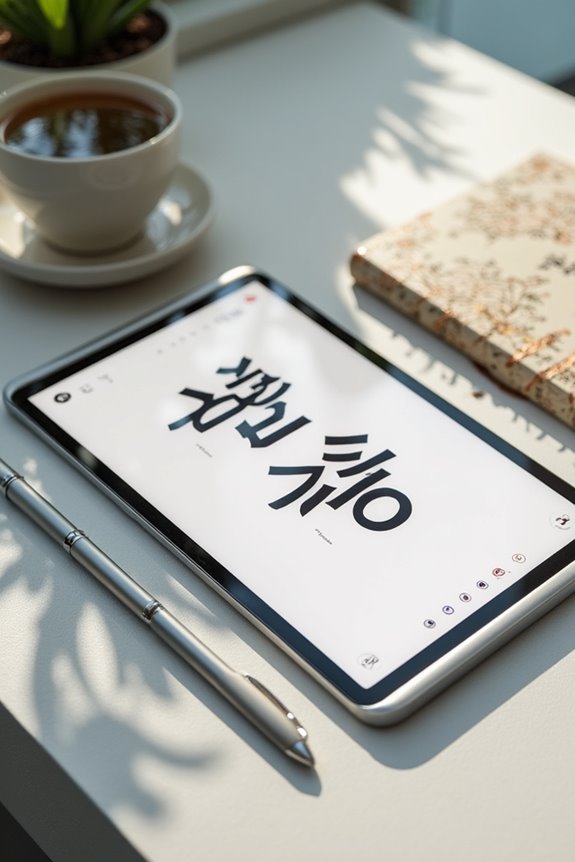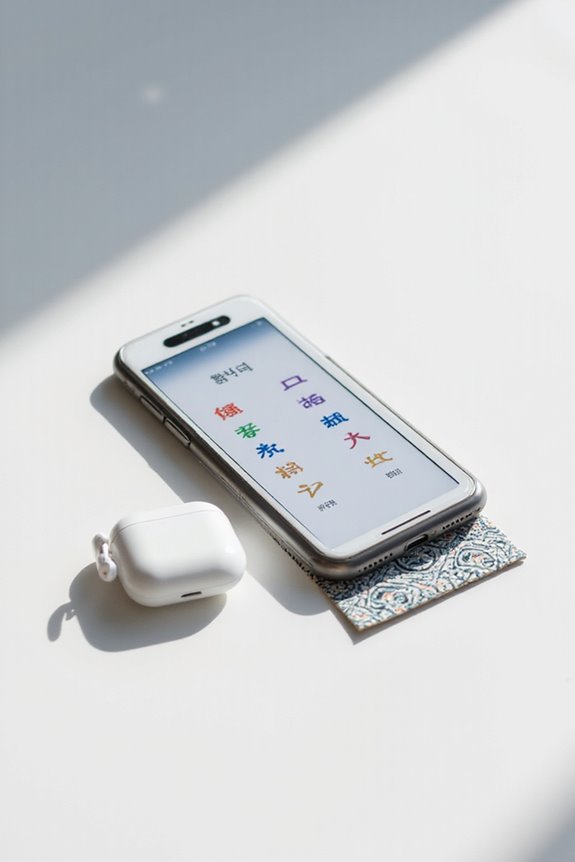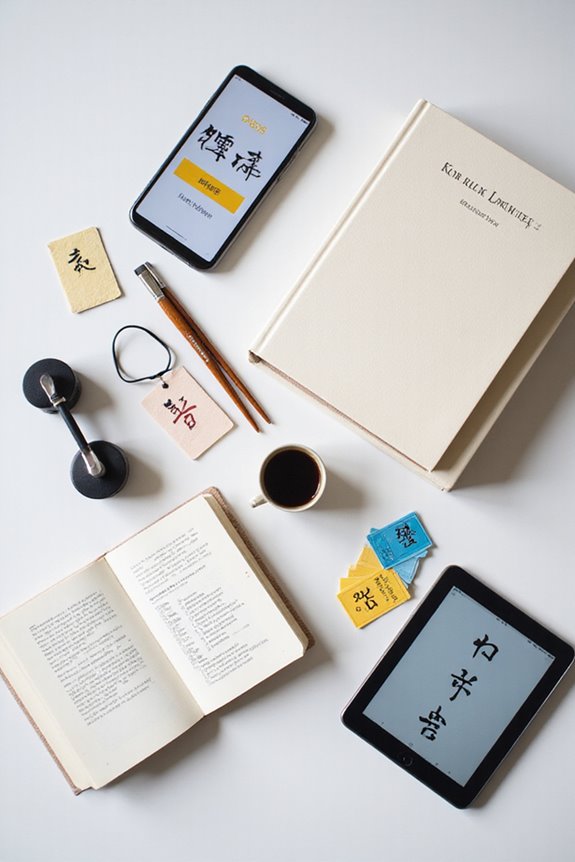To learn the Korean alphabet, or Hangul, we first need to understand its structure. Hangul consists of 40 letters, including 24 basic consonants and vowels. Each syllable block combines these letters, following strict pronunciation rules. To enhance our learning, we can use visual aids, auditory exercises, and spaced repetition for effective memorization. Additionally, practicing writing syllable combinations helps build confidence. By using varied resources, we’ll find mastery of Hangul opens doors to deeper understanding of the language.
Key Takeaways
- Start by familiarizing yourself with Hangul’s 24 basic letters, focusing on their shapes and sounds.
- Use visual aids like flashcards to enhance letter retention and recognition.
- Practice forming syllabic blocks by combining consonants and vowels through structured exercises.
- Incorporate auditory learning by utilizing sound drills and listening to native speakers for pronunciation practice.
- Regularly engage with writing and reading exercises, advancing from syllables to simple words for confidence and fluency.
Understanding the Basics of Hangul
Understanding the basics of Hangul is essential for anyone commencing on the journey to learn the Korean language. Hangul consists of 40 letters, featuring 24 basic and 16 complex letters, allowing for a vast range of sounds. Its unique Hangul structure organizes letters into syllabic blocks, where each block represents a syllable, combining at least one consonant and one vowel. This featural design symbolizes how sounds are articulated, with consonants mimicking the shape of the mouth during pronunciation. Each syllable block forms a square shape, facilitating easier reading and writing. Overall, the logical arrangement of Hangul not only simplifies learning but also enriches the experience of mastering the Korean language, making it accessible to learners worldwide.
The Importance of Pronunciation

Pronunciation is crucial for effective communication in Korean, especially as the language features a rich array of phonemes that can alter meanings considerably. Mispronunciation can create confusion, particularly given the language’s limited number of syllables and the prevalence of homophones. One of the pronunciation challenges we face involves mastering Korean’s consonant and vowel distinctions, which are key to conveying accurate meaning. The phonetic nuances in Korean also reflect social contexts and subtleties in speech, making pronunciation mastery essential. By focusing on correct sound production, we can enhance comprehension and improve our listening skills. Ultimately, achieving proper pronunciation establishes a strong foundation for fluency, thereby facilitating smoother interactions with native speakers and enhancing our overall learning experience.
Building Syllables: Consonants and Vowels
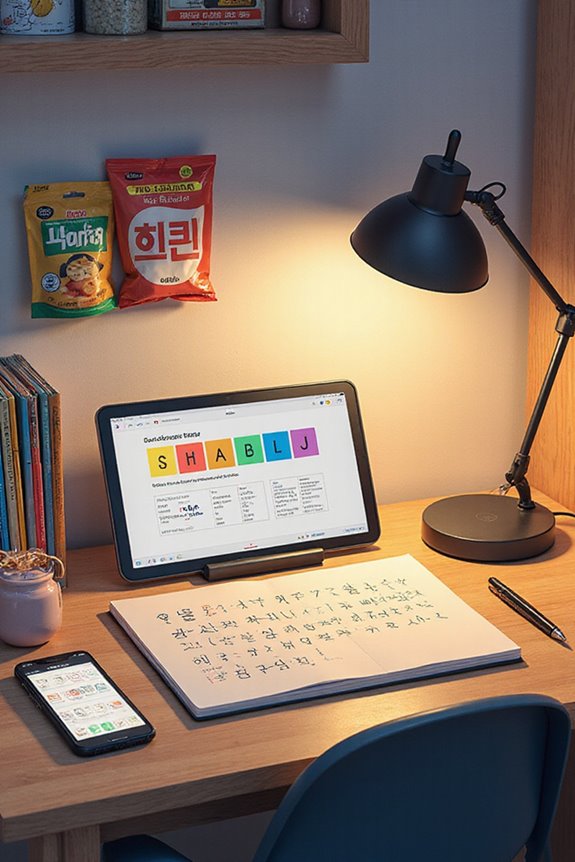
When we explore the building blocks of the Korean language, we discover that syllables are constructed using a distinct arrangement of consonants and vowels. Korean syllable construction typically features an initial consonant, followed by a vowel, with the option of a final consonant. This results in diverse syllable patterns, such as consonant combinations and complex syllables that incorporate double vowels or consonants. Understanding vowel types is essential, as vertical and horizontal vowels are placed differently in the syllable block. For instance, 가 (ga) represents a simple structure, while 맛 (mat) includes a final consonant. Each syllable follows strict pronunciation rules, ensuring clarity within the phonetic structure, which shapes how words are formed and pronounced in Korean.
Effective Learning Strategies
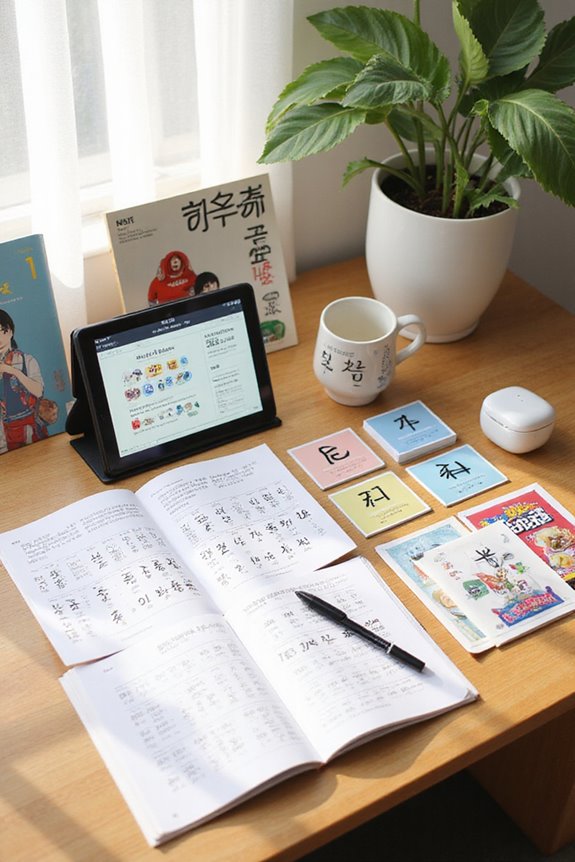
Having grasped the basics of syllable construction in the Korean language, we can now explore effective learning strategies that enhance our acquisition of the Korean alphabet, known as Hangul. We should utilize visual aids like flashcards, which display letters on one side and pronunciations on the other, boosting our retention considerably. Incorporating auditory exercises, such as sound drills and recording pronunciation, enhances our understanding of letter sounds. To avoid cognitive overload, breaking down the alphabet into smaller groups and employing spaced repetition is essential. Finally, using mnemonic devices linked to letter shapes aids memorization, while multisensory learning practices, including writing and vocalizing letters, further solidify our grasp of Hangul, facilitating a more efficient learning experience. Utilizing educational products like flashcards can provide structured lessons and extensive resources to support your learning journey.
Utilizing Language Learning Resources
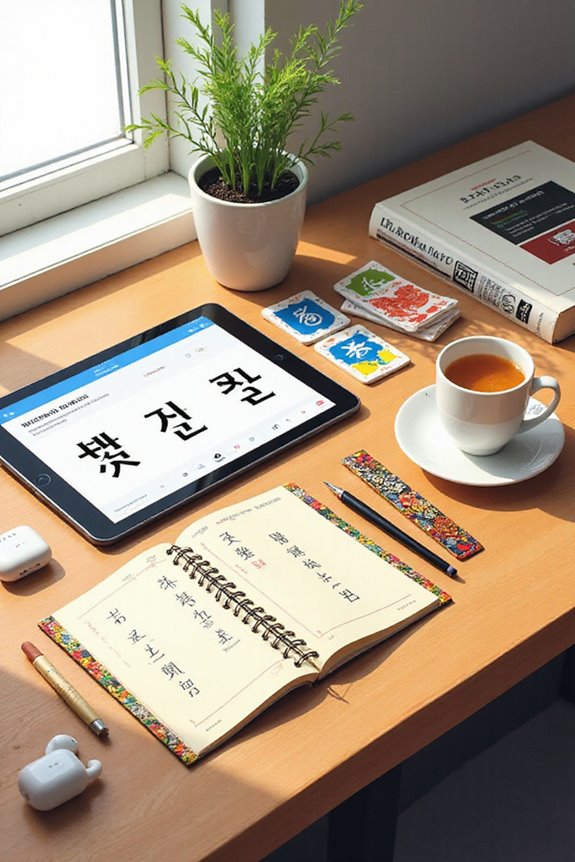
Utilizing various language learning resources can greatly enhance our journey in mastering the Korean alphabet, Hangul. We can start by exploring online resources like 90DayKorean, which offers a free PDF and interactive lessons for quick learning. Additionally, LingoDeer’s app provides bite-sized lessons focused on reading and writing. For thorough audio-visual content, Talk to Me in Korean serves as an excellent community resource, catering to all skill levels. Interactive platforms like Sogang University also reinforce our Hangul knowledge through engaging exercises. Moreover, using flashcards from Quizlet allows for repetitive practice, which is essential for retention. By leveraging these diverse tools, we can effectively improve our understanding and recognition of Hangul characters in various contexts. Furthermore, incorporating resources like the Korean Alphabet Writing Workbook can provide a structured approach to mastering Hangul writing.
Practicing Writing and Reading
Practicing writing and reading Hangul is essential for developing a solid foundation in Korean language skills. We need to start by mastering writing techniques, such as understanding syllable blocks, which combine consonants and vowels into cohesive units. Each block represents a syllable, positioning letters vertically or horizontally according to their structure. Additionally, focusing on correct stroke order enhances our writing speed and legibility. As we write, we reinforce our recognition of these shapes, promoting reading fluency in the process. We should also progress from basic syllables to simple words, helping us build confidence. Regularly practicing syllable combinations and writing familiar vocabulary will further deepen our understanding and improve our overall language proficiency. Engaging with resources like Korean Short Stories for Beginners can also boost your reading practice by providing context and vocabulary in a dual-language format.
Embracing Cultural Immersion
Embracing cultural immersion is essential for effectively acquiring the Korean language, as it enhances our understanding through real-life experiences. Living with Korean host families offers significant advantages; we gain exposure to everyday conversations and the practical use of Hangul, reinforcing both written and spoken language skills. Involvement in community activities, such as local festivals or markets, allows us to engage with authentic signage and announcements, further embedding the Korean alphabet in our daily lives. Additionally, meaningful cultural exchanges deepen our grasp of idiomatic expressions and contextual nuances, which often differ from classroom instruction. Through these interactions, we not only practice the Korean script but also develop a rich understanding of the culture, enhancing our overall learning experience.
Expectations: From Learning to Fluency
While mastering Hangul is an essential first step in our journey toward fluency in Korean, it’s important to recognize the broader expectations that come with this learning process. Initially, we’ll celebrate learning milestones as we quickly grasp Hangul, often achieving basic mastery in just 20 minutes. However, we must also understand that attaining full fluency involves a substantial commitment, typically requiring around 2200 hours of study. This fluency timeline emphasizes that while reading simple words can build confidence early on, genuine fluency encompasses listening and speaking skills. Adopting immersive techniques, such as using Korean media, will enhance our ongoing learning, ensuring we progress effectively from understanding Hangul to communicating confidently in the Korean language.
Frequently Asked Questions
How Long Does It Take to Learn Hangul Completely?
We can learn Hangul quickly, often mastering the basics in just a few hours with focused time commitment. Our learning pace varies, but regular practice guarantees we gain confidence within a week or so.
Are There Any Specific Apps Recommended for Hangul Learning?
When considering apps for Hangul learning, we should explore interactive games and flashcard apps. They make the process enjoyable and effective, enhancing vocabulary and reinforcing what we’ve learned through engaging and fun activities.
What Are Common Pitfalls to Avoid While Learning Hangul?
While learning Hangul, we should avoid phonetic confusion by mastering consonant sounds to prevent character similarity errors. Regular practice, good resources, and focused listening can help us overcome these common pitfalls effectively.
Can I Learn Hangul Without Prior Language Experience?
When we first started learning Hangul, it felt like assembling a puzzle. We’ve found that with self-study tips and language immersion, anyone can join us on this rewarding journey, no prior experience needed!
Is There a Specific Time of Day Best for Studying Hangul?
We’ve found that studying Hangul is best during mid-morning when our motivation peaks. Although evening focus shifts, we should still engage in light reviews, ensuring we reinforce what we learned earlier in the day.

